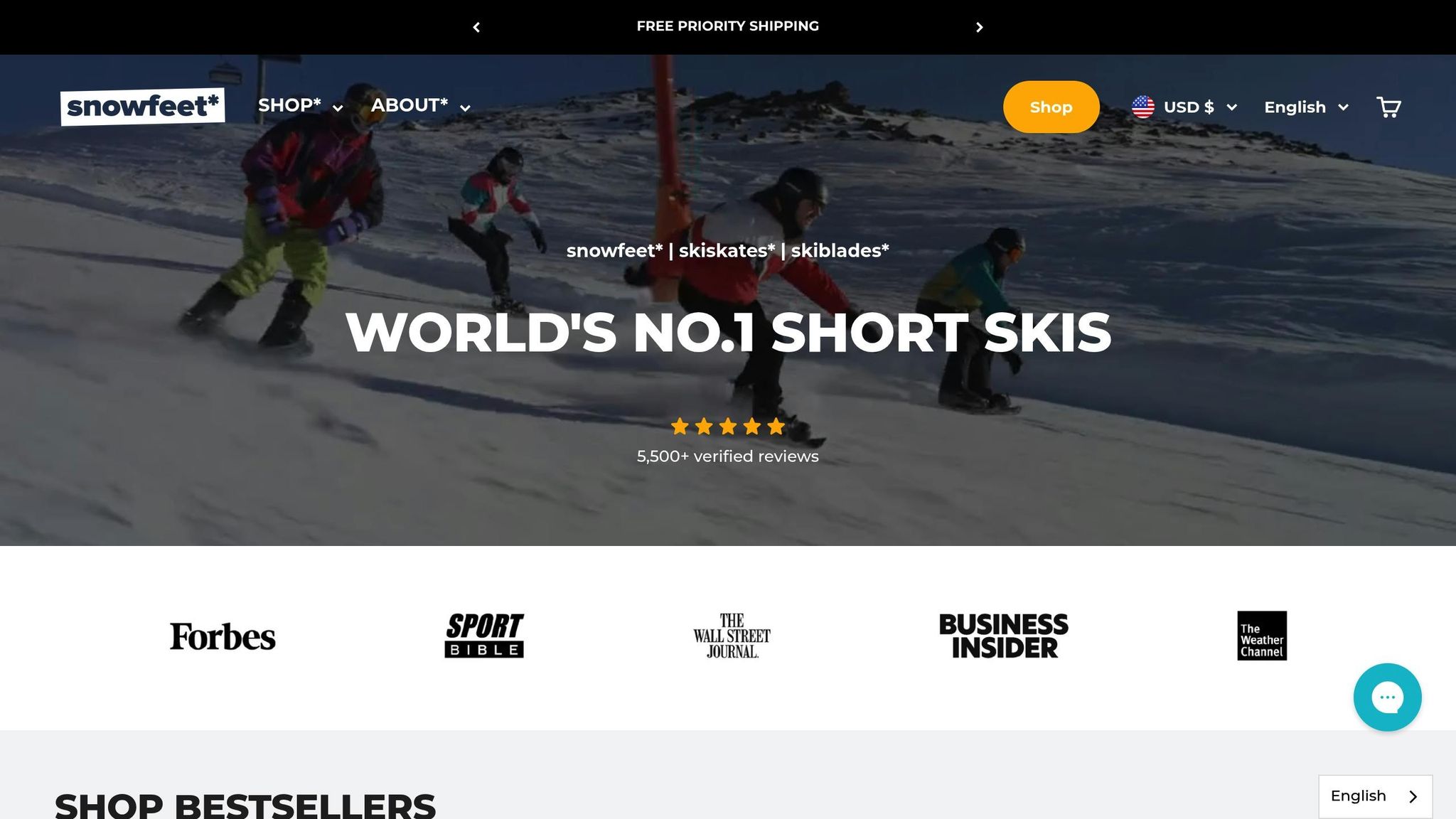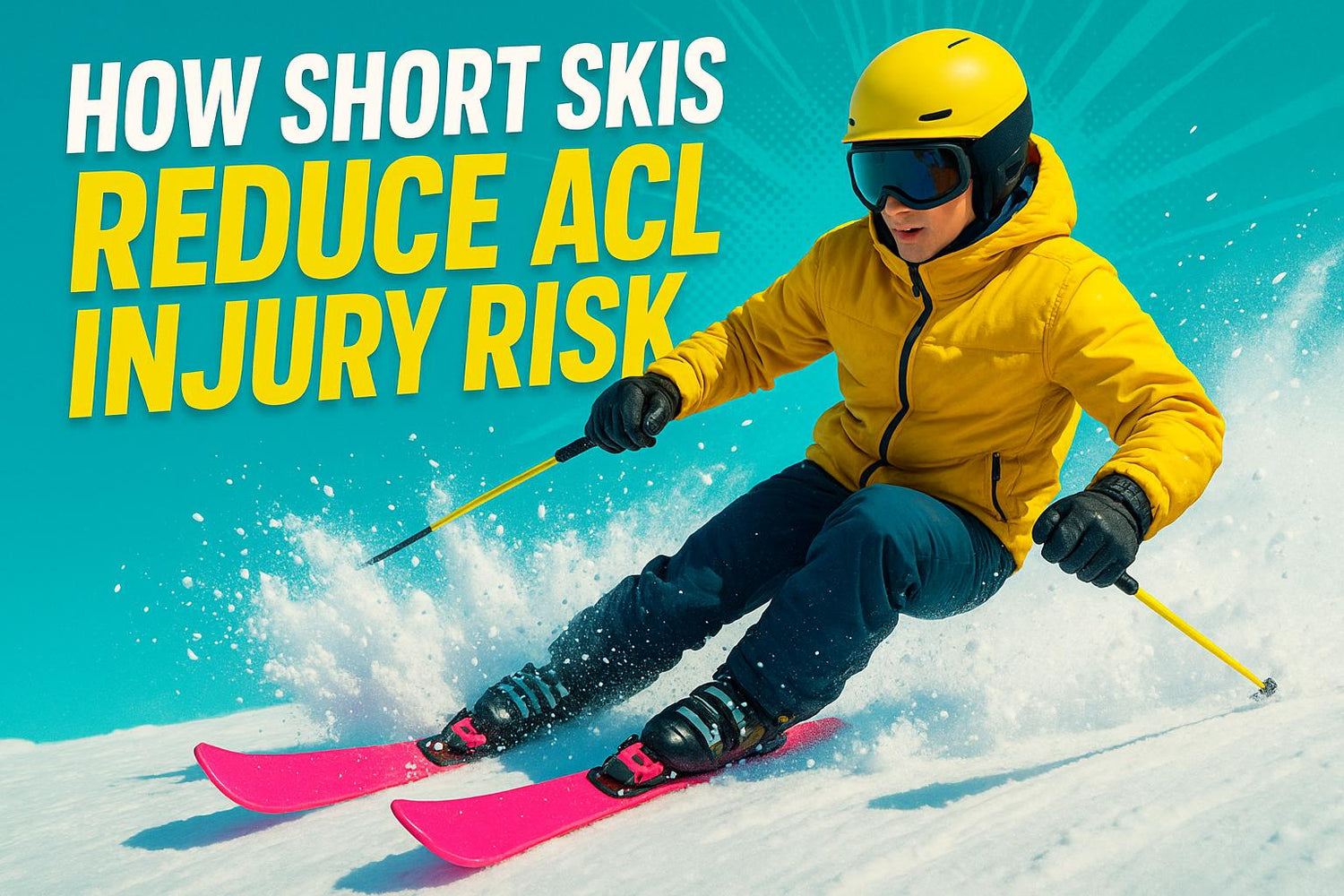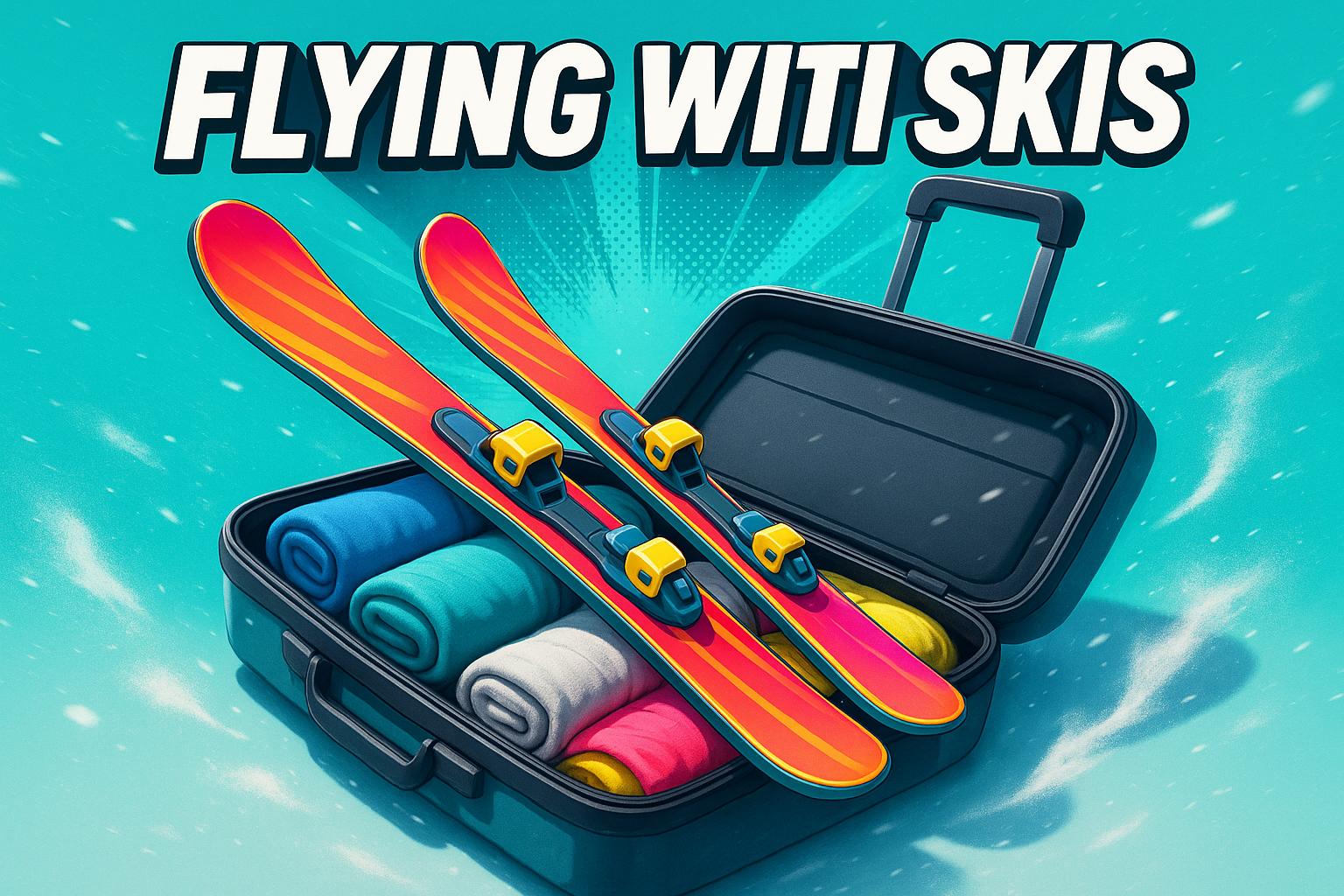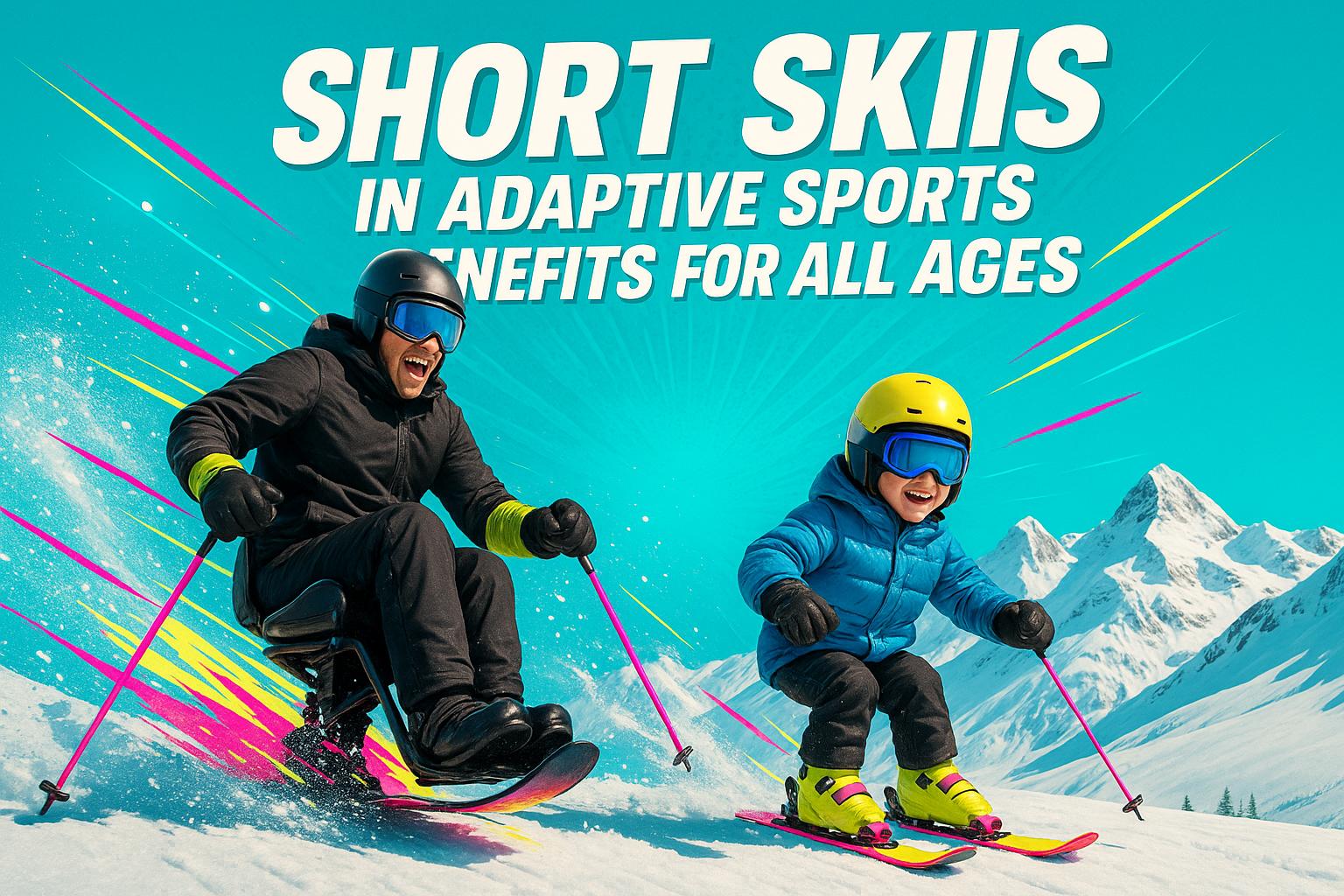Short skis can make a big difference in keeping your knees safe while skiing. Here’s the bottom line: shorter skis reduce the strain on your knees, lower the risk of ACL injuries, and are easier to control compared to longer skis. Why? It’s all about physics. Long skis act like levers, amplifying the force on your knees during falls or sharp turns. Short skis, like those from Snowfeet, minimize this leverage, making skiing safer and more enjoyable.
Key Takeaways:
- Less Knee Strain: Short skis reduce the torque on your knees, lowering ACL injury risks.
- Better Control: Easier to maneuver, helping you avoid catching edges or awkward landings.
- Safer Design: Features like forgiving flex and smaller turning radii make short skis a smart choice for skiers of all levels.
If safety and fun are your priorities, short skis are worth considering. Let’s dive into how they work and why they’re a game-changer for your knees.
Why ACL Tears Happen When Skiing
How Short Skis Lower Knee Strain and ACL Risk
Short skis are gaining attention for their ability to reduce knee strain and lower the risk of ACL injuries. While traditional ski brands like Rossignol and Atomic still focus on longer skis, shorter options are proving to be a safer alternative, thanks to simple physics and better control.
Shorter Skis = Less Knee Torque
Here’s the deal: shorter skis mean less leverage on your knees. The Snowfeet* team explains it well:
"When you are skiing on longer skis, there is more leverage on the joints, which can put more strain on the knees."
This leverage comes into play when a ski acts like a lever during a fall or awkward movement. The longer the ski, the more force it places on your knees. Short skis, usually measuring 70–100 cm (28–39 inches), reduce this leverage significantly. Less force means less strain on your ACL, whether you’re cruising down the slopes or recovering from an unexpected slip.
Improved Control for Safer Skiing
Beyond physics, shorter skis offer another big advantage: better control. Since they’re easier to maneuver, they help reduce the chances of catching an edge - a common cause of ACL injuries in recreational skiing. Their smaller side-cut radius allows for quicker, more predictable turns, making it easier to avoid awkward positions that could lead to injury. When you can correct your movements quickly, you’re far less likely to turn a small mistake into a major fall. This added control is a game-changer for knee safety.
Snowfeet* Design: Built for Knee Safety

Snowfeet* takes knee safety seriously, incorporating smart design features into their products. Their skis are built with wider profiles, a forgiving flex, and fiberglass-reinforced materials that absorb shocks and vibrations. Plus, metal ski edges and a heel brake make stopping and speed control a breeze. Unlike traditional skis that prioritize speed and performance, Snowfeet* focuses on ease of use, helping you avoid falls and awkward movements that strain the ACL. Many users even compare the experience to ice skating on snow, which naturally puts less stress on your knees.
Short skis aren’t just a fun twist on traditional skiing - they’re a safer, smarter choice for your knees. Whether you’re a seasoned skier or a beginner, the added control and reduced strain can make a big difference on the slopes.
Short Skis vs Long Skis Comparison
Short skis can help lower the risk of ACL injuries by reducing knee torque and improving control. Knowing the differences between short and long skis can guide you toward smarter choices for your knees and make your skiing experience more enjoyable.
Main Design Differences
The most noticeable difference? Length. Short skis, like Snowfeet* products, range from 28–39 inches (70–100 cm), while traditional long skis from brands like Rossignol, Atomic, and Head typically start at 60 inches (150 cm) or more. While length is the standout feature, geometry and flex are also key players. Short skis are built with wider profiles and flex patterns that absorb shocks better. Their compact design and smaller turning radius make them highly responsive.
On the flip side, traditional long skis can increase knee forces, making their design a bigger factor in knee safety, as we’ll explore below.
Effects on Knee Health
Short skis don’t just differ in design - they also ease the load on your knees. When you’re turning, the outside leg handles 60–75% of the ground reaction force. With long skis, this force is amplified due to the longer lever arms, which create more torque at the knee joint. Physical therapist Jeff Samyn, PT, OCS, CSCS, from Northern Michigan Sports Medicine Center, explains:
"Conversely, shorter, shaped skis with shorter tails make turning easier and reduce the strain at the knee joint."
This design helps cut down on the torque your knees face during turns. The ability to make quick, controlled turns means less stress on your ACL.
Comparison Table
Here’s a quick look at how Snowfeet* short skis stack up against traditional long skis when it comes to protecting your knees:
| Feature | Short Skis (Snowfeet*) | Traditional Long Skis (Rossignol, Atomic, etc.) |
|---|---|---|
| Length | 28–39 inches (70–100 cm) | 60+ inches (150+ cm) |
| Knee Stress | Lower leverage, reduced strain | Higher leverage, increased strain |
| Turning Radius | Smaller, more responsive | Larger, requires more effort |
| Control | Easier to maneuver | Harder to control, especially at speed |
| Shock Absorption | More forgiving flex | Stiffer, less forgiving |
| ACL Risk | Reduced due to better control | Elevated due to amplified forces |
| Learning Curve | Faster and more intuitive | Steeper, requiring more refined technique |
The takeaway? Short skis clearly come out ahead when it comes to knee safety and control. While traditional brands like Rossignol and Atomic focus on speed and performance, Snowfeet* prioritizes safety and joint protection - key factors in reducing ACL injury risks.
sbb-itb-17ade95
Why Snowfeet* Products Protect Your ACL Best
While many ski brands focus on longer skis for speed and performance, Snowfeet* takes a different route, prioritizing knee safety. Their short skis are specifically designed to reduce the risk of ACL injuries, offering a safer and more enjoyable way to experience winter sports.
Snowfeet* Product Options
Snowfeet* provides a variety of short ski options, all aimed at reducing ACL strain. Their Mini Ski Skates, measuring 15 inches (38 cm), are perfect for beginners. For those looking for more advanced performance, the Skiskates at 17 inches (44 cm) are a great choice. If you’re after something slightly longer, their Skiblades range from 26 to 39 inches (65–99 cm).
Each product comes with durable safety bindings that securely hold your boots, giving you full control on the slopes. A heel brake system helps you slow down easily, and the shorter length reduces the chance of injuries caused by long skis getting stuck in the snow during a fall.
"In my opinion, Skiskates is the best product for slopes we developed so far. I love how easy they are to ski and skate and how many different kinds of tricks I can perform without much effort and almost no restrictions."
- Zbyněk, Snowfeet* founder
The compact design also takes up less space on busy slopes, reducing the risk of collisions. It’s ideal for navigating tighter areas where traditional long skis can be a challenge. With over 5,500 verified reviews and a glowing 4.9/5 rating, users consistently highlight the safety and control these products offer. This combination of safety and versatility makes Snowfeet* an excellent choice for winter sports enthusiasts of all levels.
Easy Access and Simple Use
Traditional skiing often comes with a steep price tag - lessons, specialized gear, and lots of training. Snowfeet* products, on the other hand, are lightweight, portable, and can easily fit into a backpack. This portability means you can use them anywhere, from official ski slopes to your local hill or even hiking trails.
Another big win? Footwear flexibility. Unlike brands like Rossignol or Atomic, which require specific ski boots, Snowfeet* products work with regular winter shoes, snowboard boots, or even traditional ski boots. This makes winter sports accessible to just about everyone, from kids to seniors, without the need for costly boot purchases. Plus, this flexibility aligns with Snowfeet*'s focus on making skiing safer and simpler.
"These skiblades are so much fun and easy to control. Never going back to regular skis."
- Andrew B.
The learning curve is much shorter, too. Most users find Snowfeet* products easy to pick up, often without needing lessons. Their shorter skis are highly maneuverable, making sharp turns and quick stops a breeze - an essential feature for staying safe in crowded areas.
New Approach to Winter Sports
Snowfeet* is shaking up the winter sports scene by focusing on safety and ease of use. While traditional brands insist that longer skis are better, Snowfeet* challenges this idea with solid evidence and real-world results. They’re even pioneering a new winter activity called skiskating, with hopes of seeing it included in the Olympics someday.
Their philosophy prioritizes fun and safety over sheer speed. Traditional long skis often create barriers to entry and pose higher injury risks due to their bulk. Snowfeet* products, on the other hand, are lightweight, playful, and responsive, making winter sports more accessible to everyone - not just seasoned athletes.
"Easily one of the best purchases I have ever made to date."
- Vanessa, UK
The message is clear: smaller skis lead to a better, safer, and more enjoyable winter experience. This isn’t just a marketing claim - it’s backed by thoughtful design features like reduced leverage on joints, a smaller turning radius for easier control, and a forgiving flex that absorbs shocks better than traditional skis. With these smart design choices, Snowfeet* offers a safer way to enjoy winter sports while minimizing strain on your ACL.
Conclusion: Safer Skiing with Short Skis
Main Points
When it comes to protecting your knees - especially your ACL - short skis are a game-changer. Since the late 1970s, ACL sprains have tripled in frequency, but picking the right gear can significantly lower your risk. Short skis shine in this area by offering better maneuverability, thanks to their smaller turning radius. This design reduces the effort needed to turn, which in turn eases the strain on your joints. Plus, their wider build and forgiving flex absorb shocks and vibrations, giving you more control and stability. All of these features work together to reduce the chances of falls and awkward movements that can lead to injuries.
Snowfeet* takes these safety benefits up a notch. With a compact design ranging from 15 to 39 inches (38–99 cm), their products eliminate the bulkiness of traditional skis from brands like Rossignol or Atomic. Over 5,500 verified reviews, with an impressive 4.9/5 rating, highlight how these smaller skis combine safety with pure fun. Snowfeet* products are also compatible with regular footwear, making them accessible to everyone. Every design detail is focused on safety and performance, proving that these skis don’t just protect your knees - they also enhance your time on the slopes.
Try Snowfeet* Products
Want to ski safer and smarter? Snowfeet* has options for every skill level. Beginners can start with their Mini Ski Skates, which are just 15 inches (38 cm) long and perfect for building confidence. More experienced skiers can opt for the Skiskates, measuring 17 inches (44 cm), starting at $390.
With free shipping and fast delivery, you can hit the slopes sooner without the hassle of bulky gear. These lightweight skis even fit in a backpack, making them ideal for spontaneous snow adventures.
"With these little skis, you feel much more agile, faster, and above all – comfortable. No buckles, no heavy boots – just strap in and go."
– Fejta Jakub
Check out snowfeetstore.com to explore their full lineup and join thousands of skiers who’ve discovered that smaller skis aren’t just safer - they’re way more fun, too.
FAQs
How do short skis help reduce the risk of ACL injuries compared to traditional long skis?
Short skis, like those from Snowfeet*, can help lower the chances of ACL injuries by giving you better control and putting less strain on your knees. Their compact size - ranging between 44 and 65 cm - means less leverage on your joints, especially during sharp turns or unexpected falls, which are often the culprits behind ACL tears.
Compared to traditional long skis from brands like Rossignol or Atomic, which can put more stress on your knees due to their length, Snowfeet*'s shorter design is much gentler. This makes them a great option for beginners, casual skiers, or anyone renting skis. With Snowfeet*, you can hit the slopes with more confidence, knowing your knees are better protected and your skiing experience is more enjoyable.
Are Snowfeet products beginner-friendly and suitable for all skill levels?
Snowfeet gear is perfect for everyone, including beginners. Thanks to their shorter length, they’re much easier to control, making them a great choice for anyone just starting out. Unlike traditional skis that can feel intimidating at first, Snowfeet’s compact design takes the pressure off your knees and helps you learn faster while improving your ability to maneuver.
So, whether you’re dipping your toes into winter sports for the first time or you’re a seasoned skier searching for a new twist on the slopes, Snowfeet offers a fun and easy way to enjoy the ride.
How do Snowfeet short skis help protect your knees and improve control?
Snowfeet short skis stand out with their compact length, ranging from 17 to 47 inches. This shorter design helps cut down the twisting forces that are common with traditional skis. The result? Turning feels smoother, more natural, and puts less strain on your knees. That means a safer, more comfortable ride down the slopes.
Thanks to their focus on control and knee-friendly mechanics, Snowfeet skis are a great choice for anyone recovering from knee injuries or just aiming to avoid extra joint stress. They’re flipping the old idea that longer skis are always better, showing that shorter skis can bring better performance, added safety, and, most importantly, more fun.
Related Blog Posts
- Are Your Skis Too Long? Signs, Problems, and Why Shorter is Often Better
- Knee-Friendly Snow Sports: Enjoy Winter Without the Pain (Discover Gentle Gear Options)
- What Are the Most Common Skiing Injuries (And How to Prevent Them)?
- What Are the Best Skis for Someone with Previous Knee Injuries (Forgiving Options)


































Leave a comment
This site is protected by hCaptcha and the hCaptcha Privacy Policy and Terms of Service apply.